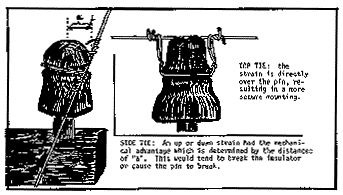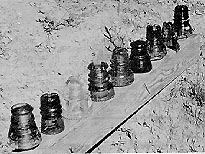Top Tie Communication Insulator
by Greg Kareofelas
Reprinted from "INSULATORS - Crown Jewels of the Wire",, September 1970, page 3
By far the greatest number of communication insulators were designed to be
tied with the wire on the side. An interesting group of insulators are
those that were designed to have the wire mounted on top. These were so
designed because of the mountainous locality most were destined to be used
in. By being "top tied" they were able to provide a more secure
mounting when used where there was a strong up and down strain on the
insulator. The illustrations below can possibly show this fact better.

The top tie insulator went through modifications from the cross top type,
which was the earliest, to the single groove type such as the Hemingray
43. Strong insulators that resisted breaking and steel pins did away with
much of the need for the top tie insulators, especially the older types.
Many of these were taken down in the 1940's and broken or the glass was remelted.

The above photograph shows all the types of top tie insulators we are
familiar with. Left to right: CD 210 No Name, double petticoat; CD 141 No
Name Cross Top; CD 214 Hemingray 43; CD 213 old style Hemingray 43; CD 208
Hemingray 44; CD 210 Postal; CD 208 California; CD 208 Brookfield.
One style of Brookfield has been located to date. The color varies from
a deep blue green to a dark emerald blue green. The No Name toll style (CD
141) has been located in light aqua green to a very dark emerald blue green, the
manufacturer is unknown. Californias turned a light shade of SCA.
The Hemingray 44 (CD 208) is usually found in blue green, a few have been found
in turquoise blue green. The older style Hemingray 43 (CD 213) is blue
green and the new style (CD 214) is both clear, blue green and emerald
green. The Postals (CD 210) come in various shades of deep blue
greens. The No Name (CD 210) Double Petticoat style is a beautiful smoke
gray, and once again the manufacturer is unknown.
Of all these styles, the California is the rarest. Or the few produced,
even fewer have survived today. The next rarest style appears to be the CD
210 No Name double petticoat. All top ties are desirable and add
considerable prestige to a collection.
On unusual top tie should probably be mentioned here. This is the top
tie threadless insulator (may be referring to a CD 785) in Gale Blosser's
collection. This insulator is made of dark green glass with many small
bubbles throughout. Many of the early poles were of the center mount type,
so a top tie insulator would have probably been a natural development.
After threads were added, this concept was neglected until it came again to be
used as a top tie for mountainous use.
The author would appreciate hearing of any top tie insulator not mentioned in
this article. This does not include the high voltage or power insulators,
of which most were a top tie variety. I hope to do the next in this series
on Transposition Insulators.
| 